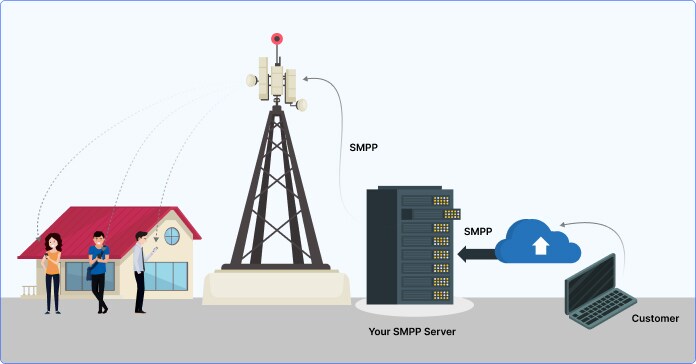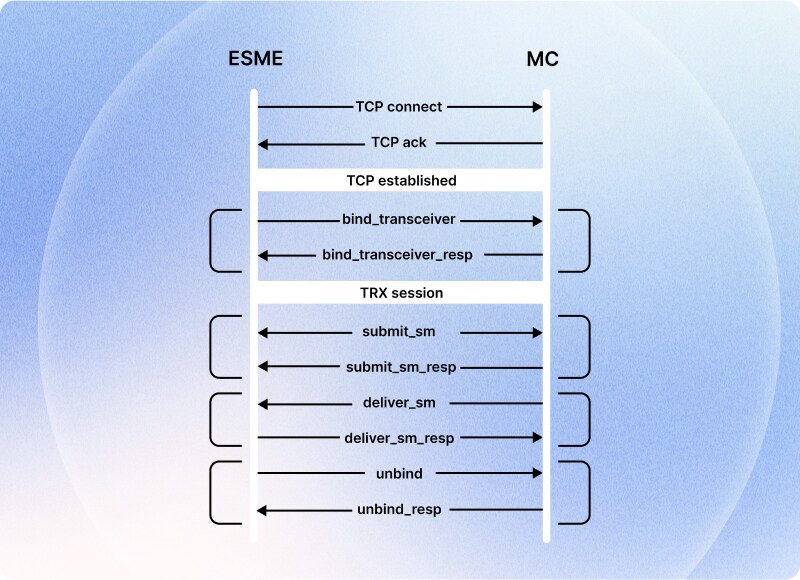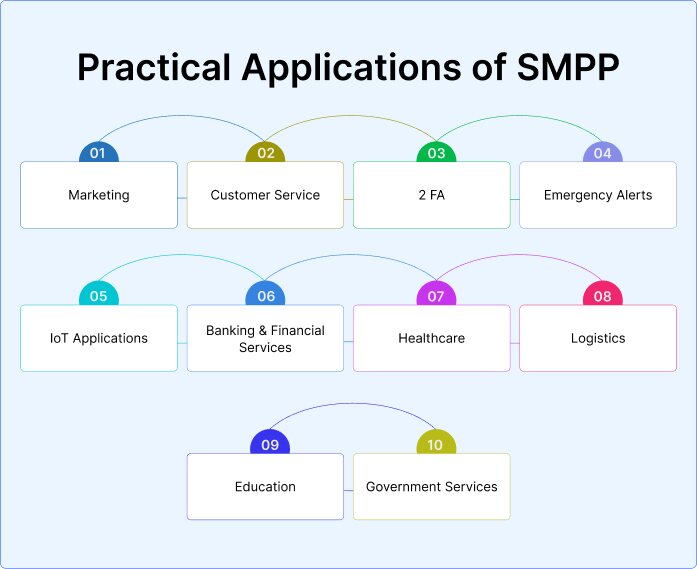
Are you in the SMS messaging business and wondering: What is SMPP? SMS is a popular communication technology in the telecommunication domain. For decades, SMS has been used by mobile users all over the world to send and receive messages of all types. Behind this powerful communication tool is the SMPP, or Short Message Peer-to-Peer Protocol, a key telecommunication industry protocol that governs how messages are routed between applications and mobile networks. This blog post provides a technical overview of SMPP, that powers many of the world’s text messaging services.
What is SMPP Protocol?

SMPP stands for Short Message Peer-to-Peer protocol. Originally, SMPP was designed in the early 1990s to facilitate efficient, quick exchange of text messages between applications and SMS centers or SMSCs. In other words, the main objective was to address the need for a standardized protocol to exchange short text messages between different entities in the telecom domain.
What is SMPP Gateway?
As the term suggests, an SMPP gateway is a software application that facilitates the sending and receiving of SMS messages between different entities using the Short Message Peer-to-Peer (SMPP) protocol.
What is SMPP Server?
An SMPP server is a centralized platform that facilitates communication between SMPP clients (e.g., applications, businesses) and SMSCs (Short Message Service Centers).
What Protocol Does SMS Use?
Primarily, SMPP is the protocol used for the transmission of SMS messages. Additionally, there are several other protocols used in SMS messaging including MAP (Mobile Application Part), SIP (Session Initiation Protocol), and UCP/EMI (Universal Computer Protocol/External Machine Interface).
While there are other protocols available for SMS messaging, using SMPP is considered quite beneficial because of its speed, reliability, and ability to handle high message volumes. SMPP also provides delivery reports, a plus point that enables businesses to track the status of each message.
With this, you might get curious to know whether SMPP is only used for text messages or if can it be used for multimedia messages/ MMS. The answer is yes, SMPP is only used for text messaging. For multimedia messaging, there are other protocols being used such as MM1.
What are the Different Versions of SMPP?
To understand the evolution of SMPP, let’s delve into the different versions of the protocols released and used till date.
- SMPP 3.3
The first standardized version, SMPP 3.3 laid the foundation for SMS messaging between external applications and SMSCs. This version of SMPP is quite basic as it supports simple SMS functionality along with submission and delivery. However, advanced features were missing in this version.
- SMPP 3.4
The next version of SMPP i.e. SMPP 3.4 came in with two-way messaging capabilities in “transceiver” mode, which allows a single connection for both sending and receiving SMS. Thus, it enables applications to send and receive messages in a single session. Alongside, it supports delivery reports and message concatenation. Because of its robustness and compatibility, SMPP 3.4 is a widely used version for a range of SMS services.
- SMPP 5.0
The latest version of this protocol, i.e. SMPP 5.0, is an enhancement to its previous versions. It supports more message types and additional data-coding options and comes with improved error reporting, security, and message handling. SMPP 5.0 allows for richer SMS content, however, it is not as widely adopted as version 3.4.
| Feature | SMPP 3.3 | SMPP 3.4 | SMPP 5.0 |
| Release Year | 1997 | 2000 | 2005 |
| Support for GSM | Yes | Yes | Yes |
| Support for Non-GSM Technologies | No | Limited | Yes |
| Support for Long Messages and Concatenation | No | Yes | Yes |
| Support for Delivery Receipts and Message Status Reports | No | Yes | Yes |
| Support for Advanced Features | No | Limited | Yes |
| Security | Weak | Weak | Stronger |
| Complexity | Simpler | More Complex | Most Complex |
| Common Use Cases | Basic SMS messaging | Advanced SMS messaging | Complex messaging scenarios |
From the above table, we can easily comprehend that each successive version of SMPP has solidified the role of this protocol in the process of messaging.
Key Components of SMPP
The working of the SMPP protocol involves some technicalities, therefore, it is better to first understand the process in simple words.
You know that SMS messages are created via mobile phones and computer systems. The process of SMS messaging follows the client server model, where:
- ESME or the External Message Entity is the Client. It is an application or software such as a messaging app that wants to send and receive text messages.
- SMSC or Short Message Service Center is the Server. It is like a Service provider that handles the delivery and routing of the text messages.
What are SMPP Sessions?
For sending and receiving SMS messages, a communication link is established between an ESME and SMSC. This link is called an SMPP session that acts as a foundational element that allows for the exchange of SMS messages, delivery reports, and other commands, ensuring seamless communication for SMS transmission.
- Transmitter (TX)
This session type is exclusively used for sending messages from ESME or the client to the SMSC or the server. Transmitter sessions are typically suitable for instances where only outbound messaging is required. For example, a bank sends transaction alerts or notifications to its customers. Here the application binds as a transmitter as it only needs to send messages and not receive any replies.
- Receiver (RX)
The Receiver session is exclusively used for enabling EME to receive messages from the SMSC. These sessions are typically useful for applications that only need to process incoming messages, without the need to send any outgoing messages. For example, a customer service platform receives SMS-based feedback from customers. Here, it binds as a receiver to process these messages.
- Transceiver (TRX)
The Transceiver session merges the functionalities of both transmitter and receiver sessions. By doing so, it allows for two-way communication in a single session, reducing the need to manage multiple connections. The Transceiver session is ideal for applications that both send and receive messages. For example, an ecommerce platform binds as a transceiver to handle both sending messages such as order confirmations and also receive messages such as customer queries.
What are SMPP PDUs?
PDU stands for Protocol Data Unit, which are the core of the SMPP protocol . SMPP PDUs are structured data packets used for communication between an SMPP client (e.g., an application) and an SMSC (Short Message Service Center). As an SMPP session gets established, these PDUs enable initiation, execution and termination of messaging functions.
They include commands like submit_sm for sending messages, deliver_sm for receiving messages, bind_transceiver for establishing a session, and unbind for terminating a session. Here’s a table showcasing commands and their respective functions:
| Command Name | Description |
| bind_transceiver | Establishes a bidirectional session between the ESME and SMSC |
| bind_receiver | Establishes a session for receiving SMS messages only |
| bind_transmitter | Establishes a session for sending SMS messages only |
| unbind | Terminates an existing session |
| submit_sm | Submits a new SMS message |
| deliver_sm | Delivers an SMS message to the ESME |
| deliver_sm_resp | Acknowledges the receipt of a deliver_sm PDU |
| submit_sm_resp | Provides a response to a submit_sm PDU, indicating success or failure |
| query_sm | Inquires about the status of a previously submitted SMS message |
| cancel_sm | Cancels a previously submitted SMS message |
| replace_sm | Replaces the content of a previously submitted SMS message |
| enquire_link | Queries the status of the link between the ESME and SMSC |
| alert_notification | Sends an alert notification to the ESME |
| generic_nack | Indicates a generic negative acknowledgment |
| enquire_link_resp | Responds to an enquire_link PDU, indicating link status |
| sms_cancel | Cancels a previously submitted SMS message (older version) |
How does the SMPP Protocol Work?
Let’s explore SMPP sessions in detail to understand how they are initiated, maintained, and terminated.

Connection Establishment or Binding
The client i.e. the ESME initiates a connection with the SMSC using one of the three modes (transmitter, receiver, or transceiver) of the SMPP protocol session. The connection is established over the TCP/IP and by default it uses port number 2775.
Sending an SMS
The client or ESME starts sending an SMS to the SMSC using the operation “Submit_SM” PDU. The SMCS processes the PDU and routes the SMS to an appropriate mobile network.
Receiving an SMS
The SMSC receives an incoming SMS message. It processes the message and sends a “Deliver_sm” PDU to the designated ESME. The ESME receives the PDU and can then display the message to the user.
Message Acknowledgement
For each message that is being sent, an acknowledgment from the SMSC is sent to the client using Query_SM to check the essage status. This tells the client whether the message was successfully delivered, queued, or failed.
Unbinding
The client then sends an Unbind command indicating the session’s end or connection. It can also terminate due to inactivity or network issues.
Practical Applications of SMPP

There are numerous real-life areas where SMPP protocol plays an important role. Let’s have a look:
- Marketing
Companies send bulk SMS campaigns and promotional messages to customers to increase engagement.
- Customer Service
Messages with information about appointment reminders, order confirmations, shipping updates, customer support notifications are sent to keep customers informed.
- Two-Factor Authentication
For online transactions, verification codes or OTPs for secure logins are sent to the registered mobile phone numbers of the users.
- Emergency Alerts
In case of emergency conditions, critical alerts, disaster warnings, and emergency notifications are sent to mass audience via messages.
- IoT Applications
IoT devices periodically send status updates and alerts to users to provide them with seamless control and insights into their connected devices.
- Banking & Financial Services
Banks and financial institutions use messaging solutions to ensure customers stay informed about their account activities and security updates. This usually includes sending transaction alerts, balance inquiries, and security notifications.
- Healthcare
Healthcare providers leverage messaging to improve patient engagement and operational efficiency by sending appointment reminders, medication alerts, etc.
- Logistics
Logistics companies use SMS to send delivery updates, tracing information and shipping notifications to customers.
- Education
Educational institutes use SMS platforms to maintain effective communication with parents, students and staff. This includes sending event updates, assignment reminders, etc.
- Government Services
Government agencies rely on messaging for public communication such as sending tax reminders and election updates.
How to Choose the Right SMPP Software?
Choosing the right SMPP software requires evaluating several key factors to align with your business needs.
1. First, assess the scalability of the software to ensure it can handle your expected SMS traffic volumes, especially if you plan to grow.
2. Look for robust features like session management, delivery reports, and support for multiple encodings (e.g., GSM 7-bit, UCS2).
3. Compatibility with your existing infrastructure, such as APIs or integration with SMSCs, is essential for seamless deployment.
4. Prioritize security features, including encryption and authentication, to protect sensitive communication.
5. Additionally, consider the cost-effectiveness and availability of support services from the provider, as well as the option for customization to cater to specific business requirements.
6. Open-source options can be ideal for budget-conscious businesses, but proprietary solutions may offer enhanced support and reliability for large-scale operations.
What is SMPP: Key Takeaway!
We have discussed the evolution of the SMPP protocol, and it is quite clear that more advanced versions of SMPP with more features and functionalities can be expected in the coming time. In particular, we can expect to see more features supporting security.
SMPP (Short Message Peer-to-Peer) is the backbone of modern SMS communication, enabling seamless, high-speed message exchange between applications and mobile networks. Its robust protocol, flexibility, and support for high throughput make it indispensable for industries relying on reliable messaging services, such as telecommunications, banking, e-commerce, and more.
Whether used via an SMPP server for managing connections or an SMPP gateway for message routing, this protocol ensures secure, scalable, and efficient SMS delivery. For businesses looking to enhance their SMS capabilities, understanding and leveraging SMPP can unlock new levels of communication efficiency and customer engagement.
Frequently Asked Questions
What security issues should I be aware of when using the SMPP protocol?
SMPP can have security vulnerabilities. So you need to be aware of issues like unauthorized access and unencrypted data transmission. To mitigate these issues, it’s important to implement security protocols and mechanisms including IP whitelisting, SSL/TLS encryption and VPNs.
How are SMPP gateways different from standard SMS gateways?
SMPP gateways typically use SMPP protocol and offer high-speed, two-way, and bulk SMS messaging. On the other hand, standard SMS gateways typically use other protocols such as HTTP and are suitable for simple, lower-volume messaging needs.
Which industries rely heavily on SMPP for their communication needs?
Industries like telecommunications, banking, healthcare, logistics, etc., include real-time communication, which is why these industries leverage SMPP due to its reliability, ability to handle high-volume and time-sensitivity.
What are the recommended port numbers for SMPP in various use cases?
By default, 2775 is the port number for SMPP which is also the recommended one for unencrypted SMPP connections. For secure connections over SSL/TLS, port 3550 is typically used. However, it is important to note that the actual port number can vary according to the SMS provider. So it is best to check with them for the specified or custom port number suited to your use case.
Can SMPP be used for international SMS?
Yes, SMPP supports international SMS. However, it is crucial to note that careful configuration and consideration of international roaming charges and regulatory compliance is required in such cases.
Can SMPP be used for two-factor authentication (2FA)?
Yes, SMPP can be used for 2FA by sending time-sensitive codes to users via SMS.
In what ways does SMPP enhance the reliability of message delivery?
SMPP establishes direct connections with SMSCs reducing the point of failure. Also, SMPP provides delivery reports, allowing senders to ascertain whether the message was successfully delivered, queued, or failed. Furthermore, SMPP efficiently maintains stable sessions through queue prioritization and rate limiting, ensuring that messages are sent consistently between sender and SMSC without unnecessary disruptions.




























